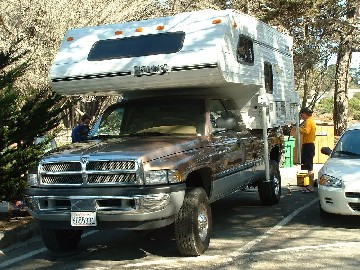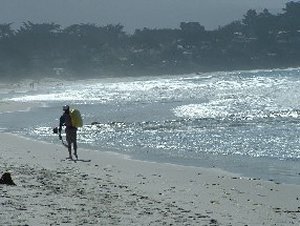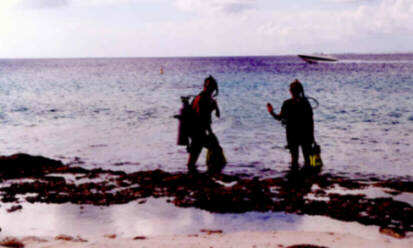Exactly one year from today, I will graduate from college. I will be 30 years old, this will be my first degree and it will have taken me seven-ish years of schooling to obtain said degree. I will have BA in Marketing, from Fort Lewis College Durango, Colorado, and then, in typical Colorado fashion, I will quit my relatively high paying job, pack up the house and hit the road. It will be just me, my husband Dan, and our Dodge Turbo Diesel 2500 Pickup, with a Lance 810 Light cab-over camper. Well that, and all of the toys we can fit in, on or behind our rig.
On June 15, 2004 we are hitting the open road. Our intended plan is to spend a year, and $15,000, driving across North America. Thus begins our journey. This book/blog will be the story of how we fulfilled our dream, complete with where to stay, how to budget, what meals are compatible with our camper oven and our limited budget, and where to go when money's running low and beer is a necessity.
My hope is that this book/ blog will make for an entertaining read, and that someone, somewhere will be inspired to follow a similar path. Or that you will read our account and realize that we were crazy people, and you'll learn from our experiences.
Really this story begins on October 30th, 2002. That is when Dan and I flew to the Oakland Airport with a cashiers check for $32, 800, in Dan's jacket, to purchase a truck and camper we had never seen in person. Living in a small town in Colorado for 12 years, has apparently removed all of the city savvy that I once valued so highly. In retrospect, meeting a stranger in a dark desolate airport parking lot, with what amounts to $33,000 in cash in our pockets, to purchase a truck we found on the Internet, is not smart. Kids don't try this at home! But apparently our karma was all in alignment and not only did the transaction go smoothly, but we fell instantly in love with this aluminum embodiment of our decade old dream.
Our first night with the camper was a rough one. We learned a few valuable lessons.
Lesson #1: when you live in a small town and are used to driving a Subaru Legacy, the change to a 3/4 ton long bed truck with a 3500 lb camper on the back and California's 101, is abrupt and truly frightening.
Lesson #2: when the rig is all loaded up, it is 11'4" tall and seems 50ft wide, clearance is an issue. It sways, it moves, it doesn't like to stop abruptly.
Lesson #3: it requires that you lock its rear door. This lesson was a hard one for us, since we never lock anything, not our house, not our cars, not our $1000+ Mountain bikes. But the trailer door likes to fly open at around 55 mph if you don't lock it.
The height issue became apparent once we reached our destination, Carmel, CA. If you have never been to Carmel, it is a charming beachside community about 2 hours south of San Francisco. The town is lush with hundred-year-old Cyprus trees. Apparently the townspeople of Carmel don't feel the need to put up height notices. As a result of this we manage to clip a tree and break our air conditioner, we have now owned this camper for 3 hours. Lesson 2: learned.

The next week was filled with many other lessons, lessons like, how to empty the black and gray water tanks, how to refill propane tanks, a camper oven cooks at a substantially higher temp than the dial says it does, how cold the desert can get at night in November, and how short some of the tunnels in Yosemite are.
Once we got her home though, life was great. We spent winter weekends camping in the parking lots of ski areas. Nothing beats getting up at 8:30 and walking to the ski lift, for first chair, and not having to pay hundreds of dollars for a ski-in-ski-out condo. Having the camper transformed normal weekend trips into real vacations. I would rather stay in my camper than in any hotel. And since our camper resides in the back of a four-wheel drive workhorse she can go virtually anywhere.
Preparation:
Now that we have procured the mode of transportation it is time to get the means. Dan and I have budgeted about $40 a day for our trip. This requires that we save $15,000 in just over a year and a half. In order to reach this we have to stow away $750.00 per month. I should interject here that we are not rich. Combined we earn around $75,000 per year; this is of course before taxes. Durango is a very expensive town to live in, and we have some pretty expensive hobbies. Fortunately Dan is a saver. He was able to pay cash for the truck; admittedly this was a big help. If we had a $600 per month truck payment we couldn't do this.
Here's how we do it. We put the money into savings with our first checks of the month. The remaining money gets divvied up in two ways. We give ourselves and allowance, around $100 each per week. This is ours to spend freely on meals out, clothes, gas, whatever, no questions asked. All remaining funds go into our mutual account from which we pay all of our bills. If we manage to save money in the mutual account we put it in savings, or put it towards my student loans. This doesn't happen often.
Of course $15,000 is not a lot. Forty dollars a day is tight, especially when you consider that as of today diesel is 1.89 a gallon. Also we do enjoy the occasional (read as daily) frosty malted beverages and those can add up, but fortunately for us, this is why God made Mexico. We intend to eat simply, cooking most meals in the camper, and buying whatever local products are most economical. However, I will not eat SPAM, anything “hashed”, parts of animals that were able to express themselves, lima beans, or anything claiming to be a “seafood special”. Also one particularly bad night in1993 left me unable to even look at chicken wings and angel food cake. Aside from these stipulations, anything goes.
Our hope is to find free camping. This is know to RV-er’s as “Boondocking”, or camping in primitive areas. “Primitive” to the average RV-er is any place that does not have electric, water, sewage, telephone, Internet, and cable hookups. Since we will not be bringing a television I think we can live without the cable. We have a small generator, which is enough to power the all important stereo and coffee maker, and to re-charge our batteries. I imagine that once a week we will stay in an established campground to handle the various pumping requirements. We intend to bring an international cell-phone, purely for emergencies, and so that our families can contact us. Most of our correspondence will be through email, we have a laptop computer and plan to find net-cafes or libraries on a weekly basis.
We are planning to do a fair amount of mooching along the way as well. Especially while in the U.S., we will be parking in friends’ driveways, begging family members for meals and beers, and otherwise ensuring that we are never welcome in their homes again.



